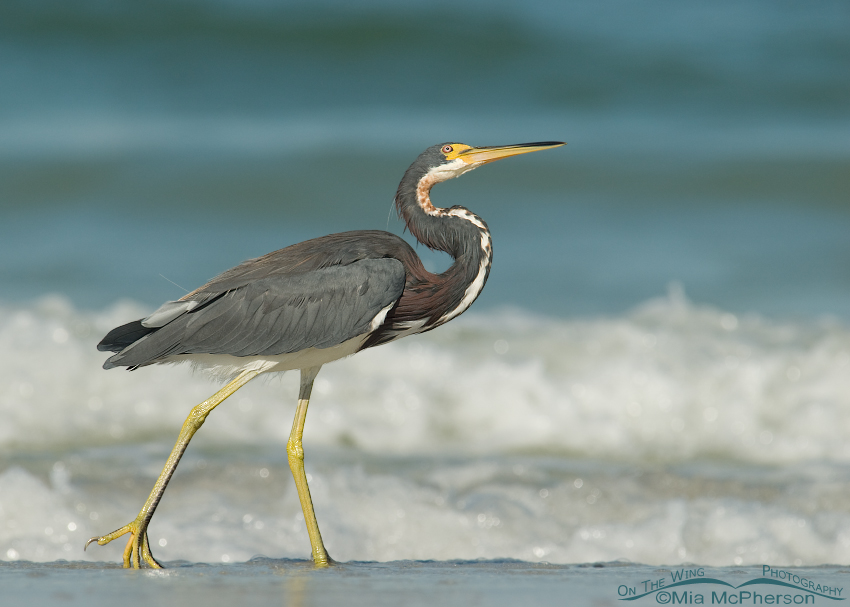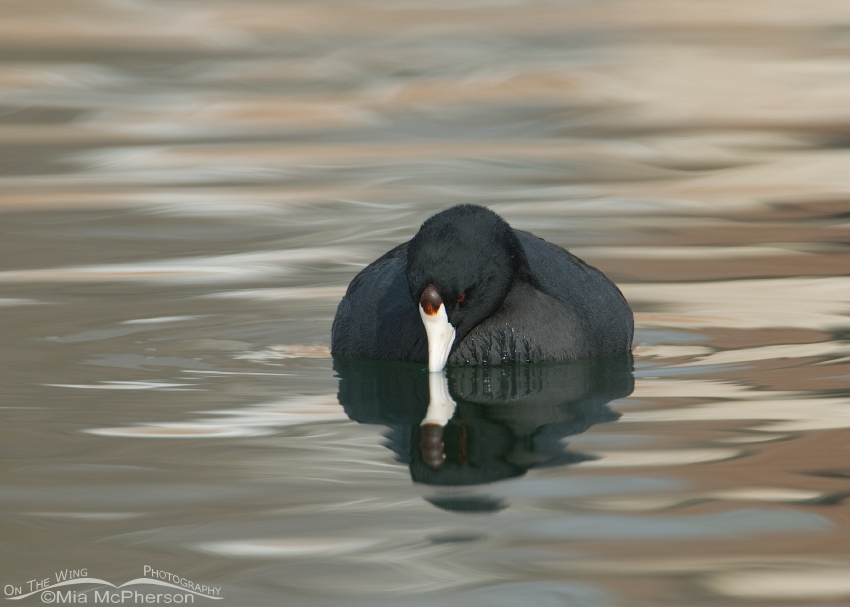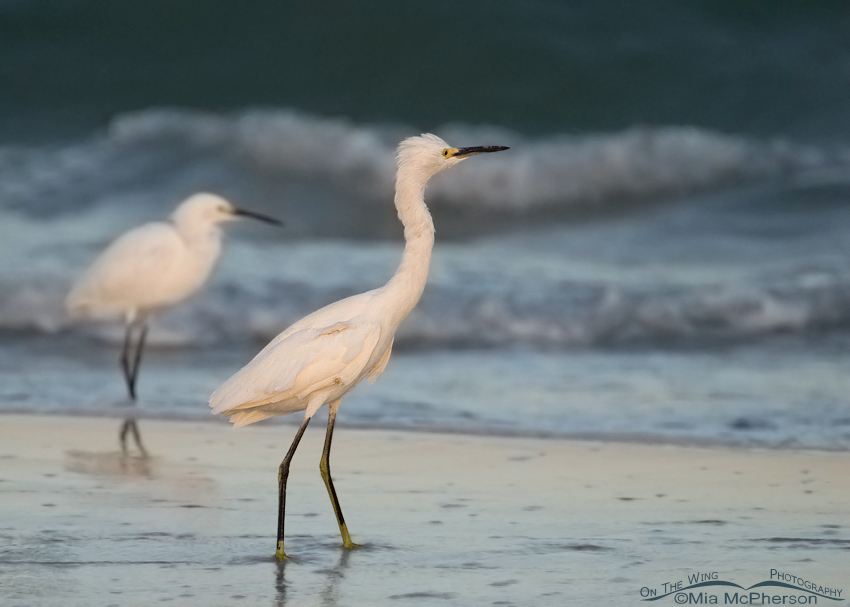 Tricolored Heron with head tilt- Nikon D200, handheld, laying flat on the sand, f6.3, 1/1500, ISO 250, Nikkor 80-400mm VR at 330mm, natural light
Tricolored Heron with head tilt- Nikon D200, handheld, laying flat on the sand, f6.3, 1/1500, ISO 250, Nikkor 80-400mm VR at 330mm, natural light
On the web there are many image critique forums and though I was only fairly active on one of the nature photography critique forums I have participated on a few since 2003 and lurked on others without participating. I believe that by receiving and giving critiques I strengthened my skills in composition, technique and learned a great deal about the birds I love to photograph. I am not currently active on those forums now simply because I can’t find the time.
I have seen some bird images posted on other forums that I found interesting and appealing but several people who critiqued the photos have talked about having the head angle 2 degrees this way or three degrees another to obtain the “perfect head angle”. I’ve pondered those critiques and personally there are times when I think different head angles; even those that do not show the “perfect head turn” can be very compelling images.
At one point in time I posted a few of my photos on the avian photography critique forum where I am a member where the head angles of my subjects weren’t perfect but where I found that I liked the images despite the lack of direct eye contact. The feed back I received was very positive, so I don’t believe I am alone with my thoughts about head angles.
In the image above the Tricolored Heron turned its head towards the sky to eyeball an Osprey flying overhead and I feel that the head being turned upwards adds interest to the image. It can make the viewer wonder what the heron is looking at. You can see the eye but the bird is just going about its life and it was comfortable in my presence.
 American Coot – Nikon D200, on Gitzo CF tripod, Black Widow head, F7.1, 1/500, ISO 250, Nikkor 200-400mm VR with 1.4x TC at 400mm, natural light
American Coot – Nikon D200, on Gitzo CF tripod, Black Widow head, F7.1, 1/500, ISO 250, Nikkor 200-400mm VR with 1.4x TC at 400mm, natural light
In this American Coot image the head angle might not be considered ideal, there is no direct eye contact or catchlight in the eye but I still feel that this is a compelling and interesting image because of the head angle and the bird’s pose and demeanor. I have more images of this coot where the head angle would be considered “better” but they do not have the same effect on me that this one does. In this image it is the head angle that draws me in and keeps my attention.
 Snowy Egrets on a stormy morning – Nikon D200, handheld, laying in the sand, f5.6, 1/500, ISO 500, Nikkor 80-400mm VR at 400mm, natural light
Snowy Egrets on a stormy morning – Nikon D200, handheld, laying in the sand, f5.6, 1/500, ISO 500, Nikkor 80-400mm VR at 400mm, natural light
In this photo the primary Snowy Egret is looking away, yet you can still see the eye. I believe the reason this image works for me is that it appears that the Snowy Egret is looking at the stormy water thus I don’t mind the head angle. For me this photo is as much about the setting as it is about the birds. I like the out of focus egret in the background, I feel it adds a tension that might not be there if that egret were absent.
The critiques I received on all three of these images were overwhelmingly positive. I believe that even without what some may consider “the perfect head angle” that we can create interesting and compelling avian images.
Mia


Really like the expression on the coot, as well as the others. Egret pose with the water and the figure in the background are well composed and interesting. So is the heron.These photos have character, eyes are in focus and show behaviours or gestures that would not otherwise have been captured and that would have been a SHAME to miss.There can be “perfect” and “perfectly boring.”
Coincidentally, saw a Great Blue fly overhead just a few minutes after enjoying your post…my attention was caught by the slows, powerful wing beats of a big bird as he crossed in front of our car…neck folded, feet tuck up, strong, steady wing beats as he/she went about the serious business of finding a good fishing spot.
Patty said it for me. And not just for artists. There are way too many rules – and unless they protect someone or something I am happy to see them broken.
And I love the intimacy of these images. It is all about the bird – rather than the photographer.
Mia, I have dozens (hundreds?) of photos that I like for one reason or another in which the head angle is not “ideal.” I strongly believe that the best nature photos are those of animals and birds engaging in behavior that characterizes their species. Yes, it is important in these photos, most of the time, to capture the bird or animal’s facial features. But, far more important is the action and whether the photo captures it accurately and in a way that tells a good story.
Thanks for the interesting post. I like your conclusion: “The critiques I received on all three of these images were overwhelmingly positive. I believe that even without what some may consider “the perfect head angle” that we can create interesting and compelling avian images.”
Beautiful photos, Mia.
The chances are highly likely that if the photographer finds an image compelling, a good portion of his/her audience will to.
So, I like that you follow your instinct in this regard.
There are many “rules” of photography, lots that I don’t yet know and in a way I’m glad of it.
I’m afraid I will become too self-conscious in my work if I’m thinking about too many rights and wrongs.
Photography is a form of art even when the photographer presents exactly what the eye and lens saw, without any photoshop-type alterations.
So, as a form of art, I like to think that “rules” are there as guidelines for photographers to improve skill and as a source of learning what’s been “well regarded” or “popular” or “successful” strategies for photographers in the past. But I also think it’s crucial, as in any art-form, for technique and results to broaden and expand.
That can only happen if the artist experiments beyond the well-worn and comfortable terrain!
“Perfect ” head angle”??? I find these all unusually interesting, because they’re what I would probably see of I was there. Like coot looking down in the water for prey, others looking up at the sky…does “perfect” mean sterotipical pose of looking downward at the water??? Which makes them all look the same…as though that’s the only behavior ever exhibited…how unnatural! Might as well take photos of statues….Your photos are a combination of scientific, biological observation and art. There are no “shoulda” in real art and “rules” are to be bent or broken….too often, critics want to put all creative, artistic people in artistic “straight jackets” and make (boring) clones of us all. I salute all those who tihink, paint, observe, photograph “out of the box”!
I reckon that’s is perfect.